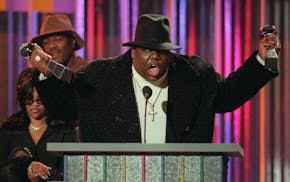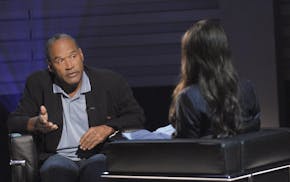The # is having a moment.
No longer just a pound or number sign, it's been born again on Twitter as a way to link tweets of the same topic or add a quick quip.
With a shiny new Internet name — hashtag — it's jumped into all kinds of nondigital places. There are hashtags on billboards, on television, knitted into sweaters at Target. Hashtag chatter has gotten so out of control that it's even been lampooned on late-night TV by the likes of Justin Timberlake and Jimmy Fallon.
If this were Twitter you might say: #Hashtags everywhere! #winning.
"It's taken on this strange cultural icon position," said Chris Messina, the Twitter user from California credited with launching the social media hashtag in a tweet back in 2007. "I just kind of sit back in awe and love the way this idea has taken off."
Even if you've never been on Twitter, the ubiquitous hashtag aims to lure you to a broader digital conversation. Words or phrases prefaced by a "#" turn into hyperlinks connecting that comment to others with the same hashtagged word or phrase.
Marketers have figured this out, and that's part of why it's plastered on every type of ad. People debate the best ways to use them — the line between entertaining and annoying is razor thin — but there's little doubt they are driving conversation.
Yet the hashtag's prevalence is a bit of a happy digital accident.
Messina, who was trying to follow a Twitter discussion of a conference called BarCamp, offered this suggestion in a tweet in August 2007: "how do you feel about using # (pound) for groups. As in #barcamp [msgs]?"
He figured that using the # before words or phrases would add context to tweets and make them easier to search and sort on Twitter. It took a while to catch on, but he and other enthusiasts kept at it.
A breakthrough came during wildfires in Southern California, when people started using #sandiegofire when tweeting about the disaster. Political hashtags came next, Messina said, and somewhere along the way it turned into a parenthetical commentary on a comment.
The hashtag spread across multiple networks — Instagram, Vine, Pinterest, Tumblr and, in 2013, to Facebook. The witty quips even seeped into speech, especially among teens. #sorrynotsorry.
Hashtags on TV
As people started tweeting while watching television, the hashtag started popping up on that screen, too.
During shows such as ABC's political drama "Scandal," following hashtags on social media can be as riveting as the show's plot lines. Cast members live-tweet during the show with the hashtag #askscandal, and each episode ends with a hashtag for fans to use if they want to discuss it further online. Reality show "The Voice" lets viewers vote to save competitors from elimination by tweeting with the hashtag #VoiceSaves.
More than half of the 2013 Super Bowl ads featured a hashtag, trying to entice television viewers into online conversations about the products, according to a survey by online ad agency RadiumOne.
The presence of those hashtags on the television screen won't drive every viewer to Twitter or Facebook or Instagram, but it connects that digital chatter with the mainstream, said Lisa Grimm, director of public relations and emerging media at Space150.
"A digital language is becoming fluent" among people outside social media, she said.
The growing hashtag habit can also be fun. Grimm likes to use them to tag videos of her dog playing with a stick — #sticktainment — and to add a smile or wink to her tweets. She added #batseyelashes to a tweet request to a friend.
"For some reason, putting a hashtag in front of a phrase or a word makes it much better," Grimm said. "It's like the 'dude' or lingo of previous generations."
But, like any slang, it can go too far, and the line between entertaining and annoying is sometimes hard to spot. Tim Johnson, of St. Cloud, who has come across such oddball hashtags as #redwhitebluejello, despises hashtags that aren't searchable.
"When I click on it, I should get more tweets that talk about something similar," he said. If not? "I just shrug my shoulders and roll my eyes at it."
Conversation catalyst
Messina thinks of hashtags as a new kind of URL. They don't come with instructions, but people have learned to go online and search for them.
Marketers have latched on to that idea, and that's a big reason the symbol is now plastered all over. They're hoping a hashtag on a billboard might prompt someone to look it up on Twitter or Instagram or Facebook.
The social networks know this, and have used hashtags to measure buzz around a topic and sell related ads. The TV networks have learned that the volume of tweets about a show can affect its Nielsen ratings.
But the increased adoption of the hashtag, for marketing or otherwise, gives people on social media a direct connection to conversations with others about mutual interests, products and events.
Keegan Shoutz, senior publicist at Lola Red PR, tuned into his Twitter feed recently while watching the American Music Awards. There, he found a fast-moving live critique of the show, from the performances to the fashion. It gave him another reason to stay glued to the show.
"It's fun to just know other people are out there watching the same things that you're watching," he said.
For Nicole Harrison, owner of social media agency Social Nicole, hashtags are also a way to meet people in real life. For instance, before a family trip to watch a space shuttle launch, she connected via Twitter with other space enthusiasts chatting on the hashtags #nasatweetup and #nasasocial.
"When you're using social media, it's not about being distant, it's about actually connecting with people," Harrison said. "[The hashtag] helped broaden the conversation."
Impressive work for a little punctuation mark.
#WorldDomination
Katie Humphrey • 612-673-4758

ABBA, Blondie, and the Notorious B.I.G. enter the National Recording Registry
West Virginia transgender sports ban discriminates against teen athlete, appeals court says
Dr. Martens shares plunge to record low after weak US revenue outlook
Visa fees for international artists to tour in the US shot up 250% in April. It could be devastating
